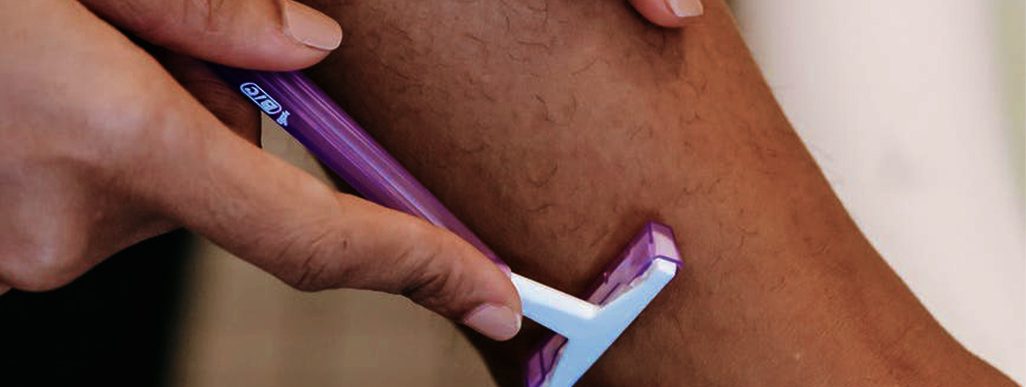Lets Talk about the basics of shaving.

The most commoly shaved areas are the underarms, legs, pubic area, eyebrows, and face for females; and the face, abdomen, back, chest, groin, and legs for males. Shaving is the most common method used for the underarms, legs, and pubic area. Pubic shaving is known to have originated in ancient Egypt and Greece when prostitutes had to shave for both hygienic reasons and as a clear sign of their profession. Although female body shaving was established as the norm between 1915 and 1945, pubic hair removal did not gain a strong foothold until the 1980’s. Today, its taken as a norm and things like bikini bathing suits have been known to reveal more of the pubic area.
There can be health consequences associated with any type of depilation: shaving, waxing, clipping, tweezing, threading, or laser treatment. Your pubic area is especially sensitive to these hair-removal techniques.
The anatomy of the pubic area consists of the Lower abdomen, Mons pubis — the soft mound of flesh raised above the genitals by a pad of fat under the skin that protects the pubic bone, which is usually much more pronounced in females than males, Genitals, Perineum— the strip of skin between the genitals and anus, Anus, Buttocks, Bikini area — The area of skin along the lower abdomen and between the legs that is exposed by bikini style undergarments.
The possible consequences of shaving could be Itching, Razor burn, Nicks, Cuts, Bumps, Blisters/Pimples, Genital infections, Ingrown hairs and lastly Folliculitis — an infection in the hair follicle usually caused by the bacteria Staphylococcus (staph) or a fungus. A common cause of folliculitis is recently shaved hairs re-growing out of the follicle and curling back around to irritate the skin.
Treatments
If you have already tried shaving and are experiencing any of the above problems, there are general treatment procedures to help. However, these are not comprehensive, and if you are having any serious problems, you should consult your medical provider.
- Itching/irritation — Apply 1 percent hydrocortisone two or three times per day. Avoid shaving for two months.
- Razor burn — Use aloe vera to soothe sensitive skin and help alleviate the pain.
- Bumps —Take a warm bath, and see your doctor if the bumps don’t clear up after one week.
- Blisters/pimples — As long as they’re not painful and don’t bother you, there’s no problem. Keep them clean and dry, and do not pick them.
- Genital infections — Consult your doctor, or visit Planned Parenthood.
- Ingrown hairs — Do not pick at them as this could cause infection. To prevent ingrown hairs, shave downward with the angle of the hair, or clip hairs instead of shaving. Also, some creams can help exfoliate the skin and relieve ingrown hairs. Check with your medical provider about these topical treatments.
- Folliculitis — If folliculitis is mild, a topical over-the-counter antibiotic will work, such as polysporin, Neosporin, or bacitracin used two or three times per day.
LEAVING YOUR RAZOR IN THE SHOWER AND USING DEODORANT AS AFTER-SHAVE ARE A JUST A COUPLE OF THE BAD HABITS YOU NEED TO BREAK.
Leaving Your Razor in the Shower
First, it’s important to know that using a razor to remove hair from the pubic area is acceptable, as long as you’re being gentle and replacing the razor as needed. Since using a new one with every shave isn’t practical or cost-efficient for most, it’s imperative that you keep it away from moisture in between uses. “To assure the blades are not corroded,” says Dr. Cook-Bolden, “clean the razor blade before and after each use,
Shaving Too Frequently In The Wrong Water Temperature
nothing feels better than a cold shower, but this is absolute torture for the hair follicles.humidity is the quickest way to soften hairs for easy removal. recommend this step for men shaving beard hair with clean washcloth warm compresses. It’s a step that’s valuable for anyone who is shaving anywhere!,Avoid steaming hot temps as well, since it has the potential to burn sensitive skin.
Using Perfumed Products In Your Private Area The cold, hard truth is that scented hair and skin products only add to the irritation or itching we experience a couple of days after shaving.
“Because this area is so delicate, during the process of cleansing and shaving, liquids can often drip onto the most sensitive internal areas leading to contact dermatitis (an intense irritation, swelling and itching).”
Not Moisturizing Post-Shave
staying moisturized below the waist is still important if you want to avoid after-shave irritation and bumps.
A men’s aftershave will help calm the skin, provide hydration, and act as an anti-septic, preventing any bacteria from entering the skin. We recommend applying a men’s aftershave regularly for up to a few days after any shaving of your pubic area to keep the area from getting irritated.


Leave a reply